Postponed: Former WSU President Honored as Part of ‘Women of Weber’ to Mark 100th Anniversary of Suffrage
Per the advice of the Utah State Governor regarding the COVID-19 virus, Weber State University is postponing this event. Please check with the event organizer for more information.
As the rest of the country celebrates the 100th anniversary of women’s right to vote this year, Utah celebrates the 150th anniversary. Women in the Utah territory received the right to vote Feb. 12, 1870, but lost it again just 17 years later when congress passed the Edmunds Tucker Act.
.jpg) "Can you imagine that?” asked Ann Millner, a Utah State Senator and former Weber State University president. “You had the right to vote for 17 years and then congress takes away your right. After that, women in Utah got very engaged in the suffrage movement both in Utah and nationally, so when Utah held its constitutional convention in 1895, both Democrats and Republicans supported women having voting rights.”
"Can you imagine that?” asked Ann Millner, a Utah State Senator and former Weber State University president. “You had the right to vote for 17 years and then congress takes away your right. After that, women in Utah got very engaged in the suffrage movement both in Utah and nationally, so when Utah held its constitutional convention in 1895, both Democrats and Republicans supported women having voting rights.”
Utah’s pioneering women helped secure the passage of the 19th Amendment, which was foundational to women’s full participation and voice in politics and in the community.
To mark these historic events and honor women who shaped Northern Utah and beyond, Weber State Archives, Special Collections and the Museums at Union Station have collaborated to present “Beyond Suffrage: A Century of Northern Utah Women Making History.”
Ann Millner's own pioneering story is one in the multifaceted project which highlights the stories of 300 women. An exhibit, opening to the public March 14 in the Grand Lobby at Union Station, examines the transformative impact of women in every arena, including education, athletics, politics, economics, health care and the humanities. The project views the 19th Amendment as a catalyst for female involvement in the growth and development of the local region. “Beyond Suffrage” includes the 50 years before the amendment (1870-1920) and the decades that follow. It also chronicles how local women continue to make history.
The exhibit encompasses multiple platforms, including internet content, photography, lectures, music and visual art. Details can be found at beyondsuffrage.org.
Women of Weber
One component of “Beyond Suffrage” is the “Women of Weber” project, which focuses exclusively on extraordinary women whose service, accomplishments, careers and philanthropy have enriched lives and educational experiences at Weber State. Each month, one woman’s photos and stories will be on display outside Archives in the Stewart Library. The March display will feature F. Ann Millner, who in 2002 was the first female selected as president of a four-year public institution of higher education in Utah. Millner led the way, and now 18 years later, half of Utah’s public colleges and universities have female presidents.
Ann Millner: Path to Education
Ann Millner’s path to education seemed destined long before she made her entrance into the world in a Kentucky hospital.
Millner was raised the only child of Gordon D. and Sue Burkhart Millner but also spent a great deal of time with her grandparents who ran a Presbyterian school in Appalachian, Kentucky. Her grandmother, Grace Burkhart, an Oklahoma native, earned a degree as a dietician in Colorado in the early 1900s, before women could vote and well before higher education was deemed important for 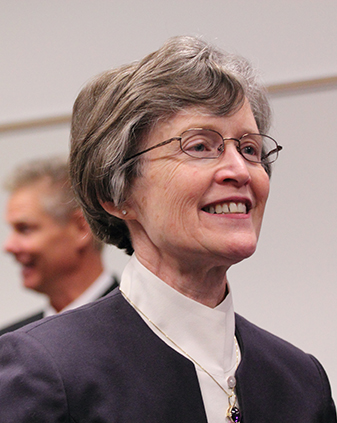 women. After graduation, she took a train and then a horse over the mountains to get to a rural Kentucky school to begin her career. Millner’s great-grandfather, a minister, had donated the land to establish a residential school dedicated to educating and caring for children living in the remote mountain areas. It was in that setting, Grace married Pope Burkhart. Millner's grandparents saved during depression times to provide an education for their three children.
women. After graduation, she took a train and then a horse over the mountains to get to a rural Kentucky school to begin her career. Millner’s great-grandfather, a minister, had donated the land to establish a residential school dedicated to educating and caring for children living in the remote mountain areas. It was in that setting, Grace married Pope Burkhart. Millner's grandparents saved during depression times to provide an education for their three children.
When Millner’s mother graduated from high school at age 16, she was the second woman in the family to board a train for new opportunities. She headed to the Gradwohl School of Medical Technology in St. Louis, Missouri, for education as a medical technologist.
Millner’s father attended the University of Tennessee on the GI Bill, following his heroic service as a World War II paratrooper.
“The story goes that my dad’s parents had to sign for him to enlist, and he saw a lot of action in the European Theatre,” Millner recounted. “He was part of the overall Normandy Invasion and was under Patton for a while. Finally he was in the Battle of the Bulge where his legs were frozen so badly, they wanted to cut them off. He would not let them, so he had circulation problems for the rest of his life, but he had his legs.”
After their marriage, the Millners worked hard and lived modestly. They believed in saving not spending; they didn’t go on vacation. Their collective commitment was to education. “I brought home a B+ once,” Millner said. “That was not acceptable.”
In retrospect, she came to realize her parents provided support not every child enjoys.
“It took watching our Weber State students work so hard and overcome so many obstacles in getting their education to realize what a wonderful thing my parents had done for me,” Millner said.
Educational Choices
As the third generation woman in her family to pursue a degree beyond high school, Millner chose the University of Tennessee.
As a teenager, her father said something she would never forget. “I want to help you get a college education, because no one can ever take that away from you,” Millner recounted. “I want you to have the ability to make your own way in life.”
A college education was an expectation, not a choice, in her home.
“At the time, I can remember thinking, ‘Well, I could be a teacher, I could go into the health field, or I could be an administrative assistant, a secretary or a related role,’” Millner said. “Whether or not it was self-imposed from my own framework of the world, it just felt like those were the choices that I had.”
Millner chose to major in science and math secondary education, but perhaps following her mother’s example, soon decided to enroll in a post-graduate program in medical technology at Vanderbilt University.
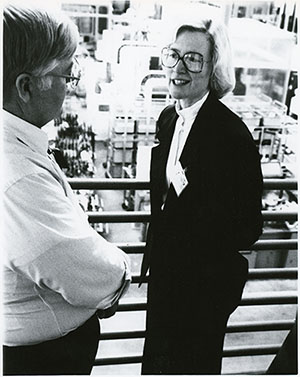 “I launched into probably one of the most difficult years of my graduate experience in college at that time, but it was interesting,” Millner said. “I finished after completing a 12-month program, and I went to work in the lab. I had the opportunity because I had both an education background as well as my medical technology background.”
“I launched into probably one of the most difficult years of my graduate experience in college at that time, but it was interesting,” Millner said. “I finished after completing a 12-month program, and I went to work in the lab. I had the opportunity because I had both an education background as well as my medical technology background.”
Millner’s drive to challenge herself with new professional opportunities manifested itself early in her career. It wasn’t long before she was ready to leave the lab. She applied and was selected as the Medical Technology Program education coordinator at Vanderbilt because of her unique combination of education preparation and medical technology experience.
“That really launched me onto the higher education side versus the clinical side, and I never turned back from there,” she said.
Education Innovation
Millner stayed at Vanderbilt a couple of years before moving to a position in a collaborative program with the University of Pennsylvania and Thomas Jefferson University. Designed for a medical technology professional who didn’t have a degree in the field, the nontraditional program was a combination of self-directed and weekend classes.
It’s impossible to see the end from the beginning, but just a few years into her career, Millner had experienced areas that she has continued to emphasize throughout her long and varied career; providing education to students of all ages; creating curriculum for nontraditional learners; supporting industry demands for skilled labor; and collaborating on programs between institutions of higher education.
Millner then moved to Southwest Texas State University to complete her master’s degree in allied health education and management. Coincidentally, Weber State’s health professions dean conducted a site visit to Southwest Texas at that same time as he explored ideas to create his own outstanding health administration program. When Millner was hired as Outreach Education director at Weber State a few years later, the university and its commitment to excellence felt familiar.
“Even then, Weber State really had a national reputation for both the quality of their programs and innovation that existed in meeting the needs,” Millner said.
Over the course of 20 years, Millner’s enthusiasm, ideas and work ethic propelled her to various positions, including School of Allied Health Sciences Outreach Education director, Continuing Education associate dean, Community Partnerships assistant vice president. After the experiences at large research universities, she connected with Weber State’s focus on learning, students and engagement with the larger community.
She was asked to lead a program now called Career & Technical Education (CTE), where she collaborated with a broad array of institutions and programs to clear a path for students to move from high school to technical school to higher education.
That work turned into a lifelong passion. During the 2020 legislative session, Millner teamed with Utah House Speaker Brad Wilson to sponsor H.B. 111, which will officially merge the university and the technical college systems. The bill also mandates easier transition of school credits between the tech schools and higher ed institutions.
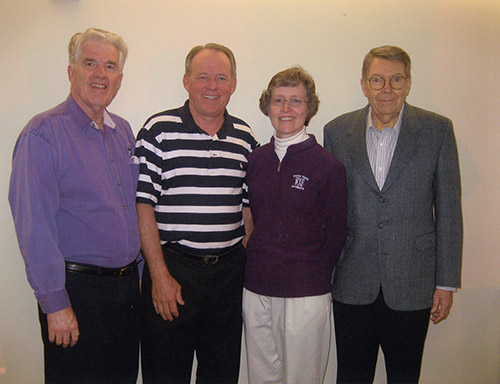 In addition to broad responsibilities for system leadership, the legislation also authorizes the new Utah Board of Higher Education to lead articulation and collaboration between the tech schools and degree-granting institutions.
In addition to broad responsibilities for system leadership, the legislation also authorizes the new Utah Board of Higher Education to lead articulation and collaboration between the tech schools and degree-granting institutions.
“We can more easily articulate credit earned from public education to technical colleges to degree-granting institutions in ways that streamline learning for students,” Millner said. “We can create these pathways, so it’s clear about how students can move through the process. We really are a K-20 system.”
Millner was involved in so many initiatives, she joked with then-President Paul Thompson she needed three different business cards. His response made her laugh: “Just pull out the right business card for whatever you’re working on.”
Millner eventually served as vice president for Community Partnerships, which morphed into University Advancement. A position she held for nine years.
In fulfilling the responsibility, she forged strong relationships with the community. She was personally engaged with numerous educational and community organizations, including Intermountain Healthcare; the Ogden/Weber Chamber of Commerce; the Weber Economic Development Corporation; the Wells Fargo Community Board and the Utah Defense Alliance.
Because of her persistence and passion for the mission of Weber State, she helped donors recognize the university’s potential. She led the university’s first capital campaign. The goal was $75 million but the campaign eventually raised $96 million.
Presidential Application
With all of those relationships and successes, looking back, Millner’s selection as 11th president of Weber State University seems inevitable. But at the time, no woman had ever led a four-year institution in Utah, nor was it considered an advantage to be an internal candidate. But she had lots of encouragement both off and on campus, especially from President Thompson.
“Women have to take risks,” Millner said. “We have to be willing to say, ‘I might not get this, but maybe I’m paving the way for somebody else.’ So that’s really what I did. There was no one more surprised than I when I got the call that afternoon saying, ‘The Board of Regents has selected you as the next president of Weber State University.’”
It came as such a surprise, Millner hadn’t even told her mother she was applying, so that was the first phone call she made after receiving the appointment.
“My mother said to me, ‘Well that’s a risk isn’t it?’ I said, ‘Yes, that’s true,’ Millner said recounting the conversation. “My mother was very risk averse. She was pretty security oriented, Depression-era. You focused on security first. So it was an interesting story.”
The story had a happy ending for both women when Millner’s widowed mother moved to Ogden in a home Millner built for her. She watched Millner lead and succeed as the 11th president.
 The night Millner received the Wall of Fame Award from the Ogden/Weber Chamber of Commerce, her mother attended, and Millner was able to acknowledge the support of her parents.
The night Millner received the Wall of Fame Award from the Ogden/Weber Chamber of Commerce, her mother attended, and Millner was able to acknowledge the support of her parents.
“It was an opportunity to publicly recognize them,” Millner said. “It was only a few months after that my mother passed away. We had to get her to the event in a wheelchair, but that made the evening even more meaningful for me.”
Weber State University’s 11th President
When Millner transitioned to president, she knew the strengths of the university, but she also knew where there was work to be done. She helped develop a 25-year master plan and vision for the university. She established the university’s core themes: access, learning and community.
For Millner, open access also means college affordability. In 2010, she launched Dream Weber, an innovative program that provides free tuition to Utah residents whose annual household income is equal to or less than $40,000, and who are Pell Grant eligible.
Nearly 10 years later, in 2019, the Utah State System of Higher Education followed Millner’s early lead and announced the Utah Promise Scholarship – the first need-based scholarship of its kind in the state. The scholarship covers tuition and fees for the first two years of college for qualifying students when federal grants fall short.
Millner had the vision, stamina and leadership skills to get others to rally around an idea and make it happen.
“I felt blessed to have the opportunity, but I also then felt a real mantle of responsibility,” Millner said, reflecting on her presidency. “As the only woman president sitting with the Council of Presidents, being in the Board of Regents meetings and being in so many different meetings where I was the only woman, I felt responsibility to represent women in a very professional way that really was able to demonstrate that women are equal to the task, and they can lead, and they can lead successfully and they can make a meaningful contribution to the institutions, to the community and to the state.”
Some of her vision included a beautified campus with revitalized buildings and grounds. During her tenure, Lampros Hall, Shepherd Union, Stewart Library and the Swenson Building were all remodeled.The campus also celebrated the construction of Elizabeth Hall, the Hurst Center and the first two buildings of the new Wildcat Village residence hall complex. The first building opened at Weber State University Davis in Layton in 2003. Funding for a second building was approved in 2011.
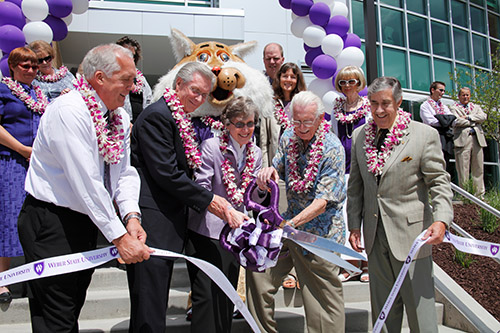 While she was president, WSU experienced nearly a 40% increase in enrollment. The university also emerged as a national leader in undergraduate research and community-based learning.
While she was president, WSU experienced nearly a 40% increase in enrollment. The university also emerged as a national leader in undergraduate research and community-based learning.
Millner immersed herself in student activities — sometimes literally. On one occasion, she donned a swimsuit and scrambled to the top of a dunk tank. The booth had been set up by student leaders hoping to raise funds for a student whose home had been destroyed by fire. No sooner had she gotten seated than student body president Kyle Braithwaite hurled a fastball smack-dab into the bullseye, plunging the president into the water. She emerged moments later with a hearty laugh.
Braithwaite told The Signpost he loved that moment, “I’m just totally impressed with President Millner. There are not many university presidents who would put themselves out there and just give it their all for a student.”
At annual Block Party back-to-school breakfasts, the apron-clad Millner regularly covered shifts at the griddle, flipping hundreds of purple pancakes for hungry students, faculty and staff. At Wildcat athletic events, she could be heard cheering at a decibel level to rival any booster in the student section.
During her presidency, Millner, an ardent sports fan, had the unexpected opportunity of representing the Big Sky Conference on the NCAA Division I Board and Executive Committee.
“I absolutely never anticipated that I would be involved nationally with the NCAA when I started in this role,” Millner said. “You do learn over time that it’s really important to be involved and engaged nationally because that has an impact on the campus.”
Nolan Karras, who was chair of the Board of Regents when she was appointed, lauded her accomplishments. “Ten years ago, Ann Millner was selected to lead Weber State University because of her experience at the institution, as well as her ability to lead faculty, students and staff. She has more than proven that she is also a key leader in Northern Utah.”
Utah State Senator
Karras’ words were both accurate and prophetic; Millner soon decided to take another risk and expand her leadership role. In 2014, Millner ran for the State Senate seat in Utah's 18th District.
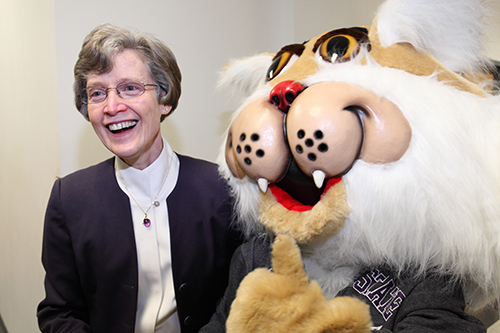 “I knew a lot about the legislative process but did not know a lot about the campaign process,” Millner said. “As I launched into it, several things came to mind. One is, I was really naïve. Second, I knew if I threw my hat in the ring, I was going to work as hard as I could, and I may not get there, but not because I didn’t put in all the work.”
“I knew a lot about the legislative process but did not know a lot about the campaign process,” Millner said. “As I launched into it, several things came to mind. One is, I was really naïve. Second, I knew if I threw my hat in the ring, I was going to work as hard as I could, and I may not get there, but not because I didn’t put in all the work.”
Because of her extensive work with the legislature during her tenure as a university president and her knowledge of education, as a freshman senator, she was assigned to several important committees that matched her focus: education, economic development and ethics.
When she ran, Millner said she wanted to serve for enough time to implement some of her ideas, such as those in H.B. 111. She’s now in her second term and is the assistant majority whip.
“I never dreamed that I would have had the opportunity to be the president of Weber State University, that I’d have the opportunity to serve in the state senate, and yet, I’ve been blessed, so blessed to have those opportunities,” Millner said. “Part of that is because of women who came before, women who blazed trails that have allowed the rest of us to follow. I’m very grateful for them.”
Millner has blazed many trails for others to follow. When she earned an honorary doctorate at Weber State University in 2014, she encouraged graduates to, “Build something spectacular.” F. Ann Millner has worked a lifetime to do just that.
For photos, visit the following link.
Allison Barlow Hess, Public Relations director
801-626-7948 • ahess@weber.edu- Contact:
Allison Barlow Hess, Public Relations director
801-626-7948 • ahess@weber.edu